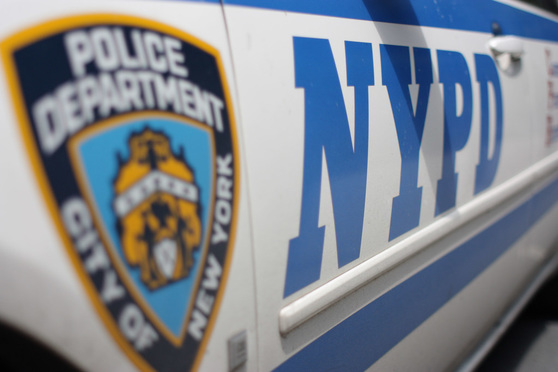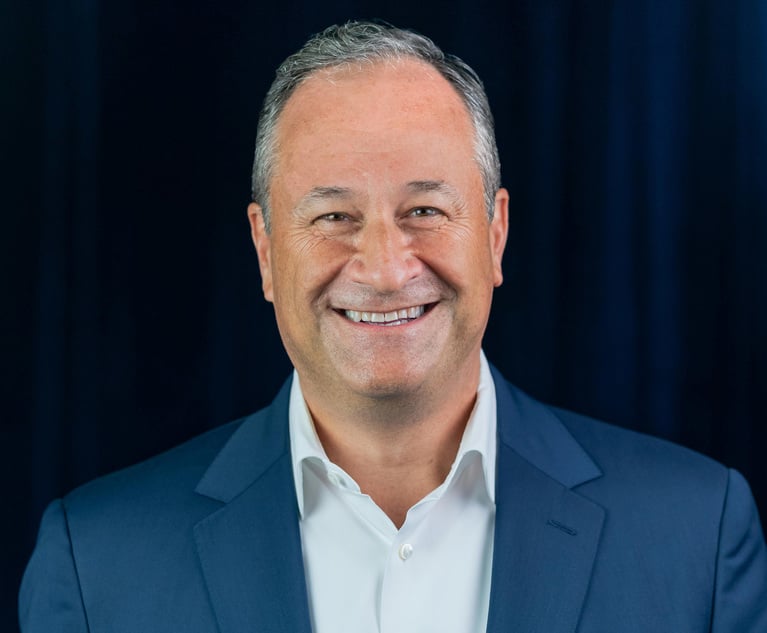Jury Returns Defense Verdict for NYPD Officers in Case Alleging Overtime Abuse
A federal jury on Feb. 23 returned a defense verdict in favor of several New York City police officers who were sued by a man who says he was wrongfully arrested for felony drug possession, foreclosing what the plaintiff's attorney had seen as an opportunity to bring alleged overtime abuses in the department to light.
February 26, 2018 at 04:41 PM
4 minute read
 New York Police car NYPD logo. Photo Credit: flickr
New York Police car NYPD logo. Photo Credit: flickr A federal jury on Feb. 23 returned a defense verdict in favor of several New York City police officers who were sued by a man who said he was wrongfully arrested for felony drug possession, foreclosing what the plaintiff's attorney had seen as an opportunity to bring alleged overtime abuses in the department to light.
But Gabriel Harvis, who represented plaintiff Hector Cordero in the case, said the so-called “collars for dollars” practice, in which officers make false arrests near the end of their shifts to clock extra overtime pay, has come up in other individual damages cases against the New York City Police Department and is an issue that is “ripe for further scrutiny.”
Cordero, a bodega worker in the Bushwick section of Brooklyn, was arrested in October 2014 after Police Officer Hugo Hugasian said he observed Cordero hand off two small plastic bags containing a white substance to Matthew Ninos and enter J&C Mini Mart, where Cordero was working behind the counter.
Officers did not find any drugs on Cordero and the Brooklyn District Attorney's Office dropped charges against him five months later.
In Cordero's civil suit against the city, U.S. District Judge Jack Weinstein of the Eastern District of New York ordered a bifurcated trial.
The first phase concerned the liability of Hugasian and other officers involved with Cordero's arrest. If the jury found that any of the defendants were liable, it would have triggered the second phase of the trial, which would have concerned Cordero's Monell claim against the department to address the broader overtime issue.
Hugasian has been written up for falsifying overtime and has been a defendant in false arrest suits filed in the U.S. District Court for the Eastern District of New York, but Weinstein limited the types of questions that Harvis could ask Hugasian about overtime abuse.
“Did you do it? Yes or no,” Weinstein said during Harvis' examination of Hugasian. “If he says no, that is the end of it. If he says yes, that is the end of it. I am not getting into the discipline. I want this minimized. This is for phase two.”
Harvis said he did not think there was an error on the judge's part, but said he may have been more successful if the trial were consolidated.
“We didn't have a complete free hand to argue the policy,” Harvis said. Baree Fett of Harvis & Fett also appeared for Cordero in the case.
In Cordero's civil case, the city maintained that there was probable cause to arrest Cordero and Assistant Corporation Counsel Philip DePaul, who appeared for the city in the case, said during opening arguments that Cordero's attorneys were bringing up the overtime issue to distract from that fact.
“In response to the court's specific question, the jury resoundingly rejected the plaintiff's claim that he was arrested to generate police overtime,” said Law Department spokesman Nicholas Paolucci in an email. Assistant Corporation Counsel Brian Francolla also appeared for the city in the case.
The NYPD has come under fire over accusations of overtime abuse in the past; it was addressed in 1994 by a committee formed to investigate corruption in the department, chaired by the late Milton Mollen, who once served as presiding justice of the Appellate Division, Second Department.
“'Collars-for-dollars is a practice widely known to officers, police supervisors and prosecutors alike,” the Mollen committee's report stated.
Twenty years later, Joseph Reznick, the NYPD's internal affairs chief, issued a memo to the department stating that some recent arrests appeared to fit the description of “collars for dollars.”
“Don't test me. Most arrests lacked quality and the end result was the same [no intelligence],” Reznick said in the memo, which was obtained by the New York Daily News.
This content has been archived. It is available through our partners, LexisNexis® and Bloomberg Law.
To view this content, please continue to their sites.
Not a Lexis Subscriber?
Subscribe Now
Not a Bloomberg Law Subscriber?
Subscribe Now
NOT FOR REPRINT
© 2025 ALM Global, LLC, All Rights Reserved. Request academic re-use from www.copyright.com. All other uses, submit a request to [email protected]. For more information visit Asset & Logo Licensing.
You Might Like
View All
Five Years After Vega Much Remains Unsettled in Pay Frequency Litigation

Spotify GC Steps Down, Opts to 'Step Away From Full-Time Corporate Life'
2 minute read
Dechert Sues Former Attorney For Not Returning Compensation

Trending Stories
- 1In Novel Oil and Gas Feud, 5th Circuit Gives Choice of Arbitration Venue
- 2Jury Seated in Glynn County Trial of Ex-Prosecutor Accused of Shielding Ahmaud Arbery's Killers
- 3Ex-Archegos CFO Gets 8-Year Prison Sentence for Fraud Scheme
- 4Judges Split Over Whether Indigent Prisoners Bringing Suit Must Each Pay Filing Fee
- 5Law Firms Report Wide Growth, Successful Billing Rate Increases and Less Merger Interest
Who Got The Work
J. Brugh Lower of Gibbons has entered an appearance for industrial equipment supplier Devco Corporation in a pending trademark infringement lawsuit. The suit, accusing the defendant of selling knock-off Graco products, was filed Dec. 18 in New Jersey District Court by Rivkin Radler on behalf of Graco Inc. and Graco Minnesota. The case, assigned to U.S. District Judge Zahid N. Quraishi, is 3:24-cv-11294, Graco Inc. et al v. Devco Corporation.
Who Got The Work
Rebecca Maller-Stein and Kent A. Yalowitz of Arnold & Porter Kaye Scholer have entered their appearances for Hanaco Venture Capital and its executives, Lior Prosor and David Frankel, in a pending securities lawsuit. The action, filed on Dec. 24 in New York Southern District Court by Zell, Aron & Co. on behalf of Goldeneye Advisors, accuses the defendants of negligently and fraudulently managing the plaintiff's $1 million investment. The case, assigned to U.S. District Judge Vernon S. Broderick, is 1:24-cv-09918, Goldeneye Advisors, LLC v. Hanaco Venture Capital, Ltd. et al.
Who Got The Work
Attorneys from A&O Shearman has stepped in as defense counsel for Toronto-Dominion Bank and other defendants in a pending securities class action. The suit, filed Dec. 11 in New York Southern District Court by Bleichmar Fonti & Auld, accuses the defendants of concealing the bank's 'pervasive' deficiencies in regards to its compliance with the Bank Secrecy Act and the quality of its anti-money laundering controls. The case, assigned to U.S. District Judge Arun Subramanian, is 1:24-cv-09445, Gonzalez v. The Toronto-Dominion Bank et al.
Who Got The Work
Crown Castle International, a Pennsylvania company providing shared communications infrastructure, has turned to Luke D. Wolf of Gordon Rees Scully Mansukhani to fend off a pending breach-of-contract lawsuit. The court action, filed Nov. 25 in Michigan Eastern District Court by Hooper Hathaway PC on behalf of The Town Residences LLC, accuses Crown Castle of failing to transfer approximately $30,000 in utility payments from T-Mobile in breach of a roof-top lease and assignment agreement. The case, assigned to U.S. District Judge Susan K. Declercq, is 2:24-cv-13131, The Town Residences LLC v. T-Mobile US, Inc. et al.
Who Got The Work
Wilfred P. Coronato and Daniel M. Schwartz of McCarter & English have stepped in as defense counsel to Electrolux Home Products Inc. in a pending product liability lawsuit. The court action, filed Nov. 26 in New York Eastern District Court by Poulos Lopiccolo PC and Nagel Rice LLP on behalf of David Stern, alleges that the defendant's refrigerators’ drawers and shelving repeatedly break and fall apart within months after purchase. The case, assigned to U.S. District Judge Joan M. Azrack, is 2:24-cv-08204, Stern v. Electrolux Home Products, Inc.
Featured Firms
Law Offices of Gary Martin Hays & Associates, P.C.
(470) 294-1674
Law Offices of Mark E. Salomone
(857) 444-6468
Smith & Hassler
(713) 739-1250






